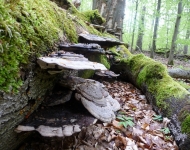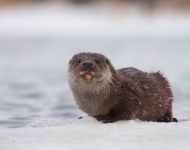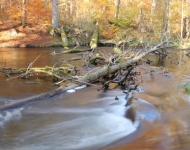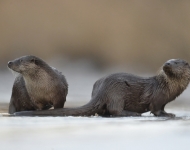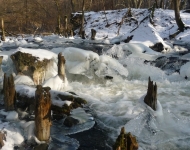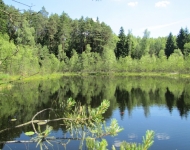Areas of strict preservation
In the strict preservations areas of the Drawa National Park ensure the protection of natural processes taking place in ecosystems. All human intervention is prohibited there. Collection of seeds is allowed, however, to ensure that the gene pool is not undersupplied when it comes to certain species of trees. Those are the areas of highest natural value and demanding a very special care to save them for future generations. The strict preservation areas totals in 569ha
Dębina*
Area: 8,50 ha.
Purpose:to preserve the picturesque hillside near Drawa overgrown with hornbeam – oak (Galio sylvatici – Carpineteum) forest – dry-ground forest – a deciduous forest dominated by hornbeam, with the addition of oak, beech, an also maple, linden, and elm. In the undergrowth are present: anemone (Anemone), liverwort (Hepatica), weasel-snout (Galeobdolon lutenum), moschatel (Adoxa moschatellina), and sweet wood-ruff (Asperula odorata).
Distinctive features:
- Over 100 years old oaks, huge lindens and beeches
- Sightseeing spot overlooking the monumental trees across the river
- Ivy (Hedera helix -protected species) crawling in all over the forest ground
Dry-ground forests are the deciduous forests most common and largest in Central Poland. In the Pomeranian landscape, however, beech forests are more popular.
In Dębuna one we can observe the process of aging and the natural dynamics of oak and beech forest
Stare Buki*
Powierzchnia: 15,27 ha.
Cel utworzenia: ochrona dorodnego lasu bukowego na pagórkowatym brzegu doliny Drawy, charakterystycznego dla Puszczy Drawskiej.
Osobliwości:
- ponad 130- letnia buczyna o typowo wykształconym zespole Melico-Fagetum’,
- cenny płat buczyny zboczowej,
- stanowisko wawrzynka wilczełyko (Daphne mezereum) i paprotki zwyczajnej (Polypodium vulgare
Radęcin*
Area: 187,47 ha.
Purpose: to protect, for scientific and educational reasons, a fragment of an oak – beech virgin forest on Drawa (the most valuable accumulation of 300-400 years old beeches and oaks).
Distinctive features:
- Oaks and beeches of up to 3m in girth and 35m in height
- Protected species: sunningdale (Daphne mezereum)
The natural processes of functioning and fluctuation of the beech forest ecosystem, the processes of spontaneous naturalization of beech forests, and the geodynamical processes on the Drawa valley hillsides, as well as the natural dynamics of hill-side forests are being protected in the Radęcin range
Grabowy Jar*
Area:3,59 ha.
Purpose:to protect a deep canyon sculpted out by a small stream that flows into Drawa, along with the beech – oak – pine forest that covers it.
Distinctive features:
- Patches of the West-Pomeranian dry forest with an adjacent forest (Galio sylvatici – Carpineteum)
- Postglacial rock considered a natural monument
- Characteristic flora of brook and well-head plants near springs
- Messes and fern present in wet spots.
The processes of aging and natural dynamics of beech – oak – pine forests salvaged from municipal usage can be observed here
Drawski Matecznik*
Area:34,94 ha.
Purpose:to protect old forests on the land level and on the hillsides of a deeply cut valley of the very rapid Drawa. Old beech woods of an acidic character are growing on the hillsides. Narrow patches of dry-ground forests are present at the river banks. The undergrowth vegetation consists of: two-leaf lily of the valley (Majanthenum bifolium), blackberry (Vaccinium myrtillus), twisted deschampsia grass (Deschampsia flexuosa), and murky lungwort.
Distinctive features:
- Large rock in the water considered as natural monument
- Stone-hill created by smaller rocks
- Forest complex typical to Drawa reception basin
- Early-blooming toothwort (Lathraea squamaria) – hornbeam root pest
- One of the three spots in the Park where service-tree (Sorbus torminalis) grows
- Presence of sunningdale Daphne mezereum) and cotton-grass (Eriophorum vaginatum).
The fluctuation and functioning processes of beech and dry-ground forests, as well, as geodynamical processes on Drawa’s hillsides and the forests’ natural dynamics are being protected in the Drawski Matecznik range
Zatom**
Area:23,84 ha.
Purpose: to protect the natural dynamics of hill-side forests and post-agricultural land
Distinctive features:
- Colourful sandy lawns
- Presence of Turk’s cap lily (Liliom martagon – protected species)
- Presence of sunningdale (Daphne mezereum) and service-tree (Sorbus torminalis)
The processes of fluctuation and natural functioning of beech woods and dry-ground forests can be observed here, as well, as the geodynamical processes of Drawa hillsides and the natural dynamics of hillside forests and spontaneous succession in post-farm lands.
Sicienko*
Area: 2,74 ha.
Purpose: to preserve, for scientific and educational use, the natural state of a very rare boreal plant northern leatherleaf (Chemaedaphene calyculata), in its furthest western location in Europe.
Distinctive features:
- Northern leatherleaf (Hamaedaphene calyculata)
- Small-leaf cranberry (Vaccinium microcarpus)
- Rare peatbog vegetation (morasses)
The development and evolution of a peatbog morasses ecosystem of an interesting history can be observed in the Sicienko range, along with the population dynamics of northern leatherleaf (Chamaedaphene calyculata), and the natural functions of a forest – peatbog landscape in the direct peatbog reception basin
Island on Lake Ostrowiec (Lech, Okrzeja, Pokrzywka)*
Area: 5,61 ha.
Purpose: to protect, for scientific reasons, plant communities and birds’ breeding grounds. The distance form lake coast provides isolation that will enable natural development of the rich world of plants and animals, especially birds, that live on these islands.
Distinctive features:
- Beautiful landscape
- Old standing timber with monumental trees
- Interesting vegetation, ex. ivy (Hedera helix)
- Safe haven for rare and protected water birds: cormorant (Phalacrocorax carbo), black stork (Ciconia nigra), dumb swan (Cygnus olor), goldeneye (Bucephala clangula), carnivorous birds: osprey (Pandion haliaetus), hen-harrier (Cirrus aeruginosus), and white-tailed eagle (Haliaeetus albicilla).
On these islands we can observe the natural fluctuation and regeneration processes in isolated ecosystem patches and the natural dynamics of fauna not interrupted with anthropogenic influences
Głodne Jeziorka*
Area: 5,61 ha.
Purpose: to preserve and protect the peatbog lakes with neighbouring peatbogs of natural vegetation rich in rare and endangered species (sundew, club-moss) and the well-head vegetation near Runica.
Distinctive features:
- 14 well developed natural complexes of water, morass, and swamp vegetation creating ecological continuations
- picturesque steep hillsides by lakes (5 forest complexes)
- rare and protected plant and animal species: sundew (Drosera), marsh tea (Ledum palustre), cotton grass (Eriophorum vaginatum), fire-bellied toad (Bombina bombina), dragonflies (Nehelennia speciosa, Aeshna subarctica, and Leucorrhinia rubicunda)
- valuable hillsidr beech wood patch with sunningdale (Daphne mezereum)
- well-head erosion complex in forest community
In the Głodne Jeziorka range we can observe the natural functions of a forest landscape with distrophic lakes and peatbog morasses that fill no-outlet kettle-like holes. We can also observe the overgrowing of lakes and development of peatbogs
Rynna Moczelska**
Area: 25,15 ha.
Purpose: to protect the outwash land with its characteristic horizontal system of gullies and the specific vegetation in the Lake Moczel area.
Distinctive features:
- forests valuable for their nature and landscape (well-head marshy meadows, patches of valuable hillside beech woods )
- vegetation: yellow water lily (Nuphar lutea), white water lily (Nymphea alba), and bulb toothwort (Caradamine bulbifera)
In this range we protect the natural processes of shallowing and overgrowing of Lake Moczel and the processes of fluctuation and regeneration in the surrounding forests
Płociczna*
Area: 80,45 ha.
Purpose: to preserve the water-forest ecosystem of River Płociczna and its banks in order to ensure the well-being of all plant and animal communities in their natural environments
Distinctive features:
- picturesque and uniquely diverse landscape
- diverse vegetation: sunningdale (Daphne mezereum), blood orchid (Dactylorhiza incarnata), broad-leaved orchid (Dactylorchiza majalis), southern adder’s tongue (Ophioglossum vulgatum), running clubmoss (Lycopodium clavatum), stiff clubmoss (Lycopodium annotinum), mud-star (Stellaria alsine), and manna (Glyceria nemorali)
- presence of Atlantic salmon (Salmo salar)
In this range we observe the natural functions of a mid-forest river valley ecosystems, the geodynamic processes on its hillsides and the fluctuation and regeneration in the hillside forests
Źródliskowy Grąd*
Area: 35,13 ha.
Purpose: to protect the forest complexes (Melico-Fegetum, Galio silvatici-Carpinetum) on steep hillsides of Drawa’s river valley with its characteristic vegetation (well-head swamps and a rich variety of mosses)
Distinctive features:
- monumental oaks and beeches
- beautiful hornbeams of about 2m in girth, with the early-blooming pink toothwort (Lathraea squamaria), sunningdale (Daphne mezereum), twayblede (Listeria), and meadow-grass (Poa remota)
- “Devil’s Circles” created by fungi: Ramaria formesa and Clitocybe infundibulis
- well-head plant communities (Montio-Cardaminetea)
Here we protect the natural functioning of well-head and forest hillside geoecosystems
Delta Płocicznej**
Area: 17,62 ha.
Purpose: to protect the natural sediment-forming processes in Płociczna’s delta by its estuary to Lake Płociczno, and the swampy landscape with their natural character
Distinctive features:
- land forms characteristic for a delta (main bed, distribution bed, lagoon, pouring cones, and steep frontal land-drop) and unique on the national scale
- swampy forest landscape with characteristic vegetation: grass of Parnassus (Parnassia palustris), two-stem valerian (Valeriana dioica), sunningdale (Daphne mezzereum), pink toothwort (Lathraea squamaria), and snake pondweed (Polygonum distorta)
- characteristic fauna: marsh-harrier (Cirrus aeruginosus), eared owl (Asio otus), and beaver (Castor fiber).
In this range we observe the developmental stages of the delta and ecosystem successions
Poziomkowy Las*
Area: 31,01 ha.
Purpose: to research the natural vegetation succession in artificially planted pine forests with a fertile deciduous forest undergrowth. A place of unique experimental character.
Distinctive features:
- presence of the very rare in Pomerania protected species of clubmoss (Huperzia selago)
- diversity of landscape (old tree complexes, well-head marshlands and sedges, coastal reeds and rushes)
- protected species: sunningdale (Daphne mezereum), common fern (Polypodium vullgare), and stiff clubmoss (Lycopodium annotium)
In this range we observe the processes of regeneration and naturalization of a forest planded on post-farm land
Wetlands by Drawa**
Area: 2,64 ha.
Purpose: to preserve the diversity of the Drawa river valley.
Distinctive features:
- beech woods and meadows complex
- coastal osier-beds
- plants: odd violet (Viola mirabilis), primrose (Primula veris), wide-leaf fern (Dryopteris dilatata), and white poplar (Populus alba)
- sometimes a goldeneye appears
Bagienko and Ostrowiec**
Area: 9,76 ha.
Purpose: to protect a valuable reptile environment and swamp vegetation
Distinctive features:
- complex of rushes, alder forests, and meadows
- flora: mud-star (Stellaria alsine) and cotton grass (Eriophrum vaginatum)
- fauna: fire-bellied toad (Bombina bombina)
Wydrowe Łęgi**
Area: 3,60 ha.
Purpose: to protect and preserve the valuable plants and diverse landscape
Distinctive features:
- diverse landscape (old woods, well-head and post-meadow marsh)
- destroyed well-head peatbog with characteristic vegetation
- flora: stag’s-horn clubmoss (Dipharsium complanatum), sand sedge (Carex arenaria), and odd violet (Viola mirabilis
Marshes near Płociczna**
Area: 5,86 ha.
Purpose: to protect the marsh-alder complex structure
Distinctive features:
- valuable marsh-alder complex
- wellheads
- presence of birch valerian (Valeriana officinalis sambucifolia
* Created as a nature reserve before the park founding, by a legislative statute of the Forestry and Wood Industry Minister. As the National Park was created in 1990, the reserve area was included within the Park borders. By law, National Parks are the highest form of nature preservation, so they wouldn’t necessarily need to include additional reserves within their borders. In 1992 the these areas were removed from the list of nature reserves (as per the legislation ruled by the Minister of Environment and Resources Conservation from 11 February); however, their natural value did not diminish. When a legislation for nature preservation plans for national parks will come to life (incl. the DNP) this area will be under strict protection in the DNP.
** In planning. When a legislation for nature preservation plans for national parks will come to life (incl. the DNP) this area will be under strict protection in the DNP


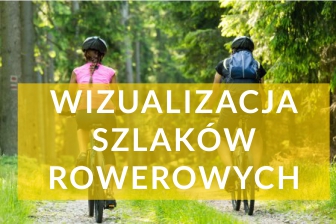

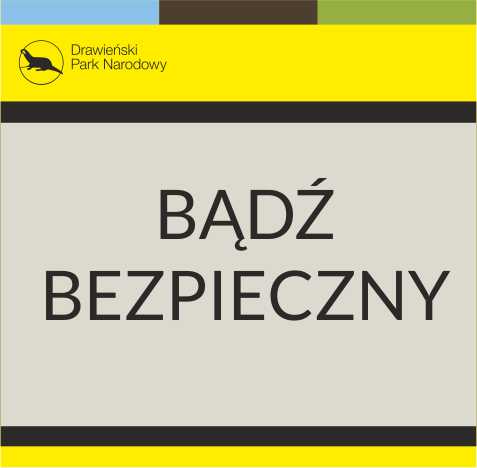

Search
Gallery
Newsletter
Będziemy informować Cię o nowościach w serwisie oraz ważnych wydarzeniach w Parku.
Contact
ul. Leśników 2, 73-220 Drawno,
tel.: (095) 768 20 51,
(095) 768 20 52
fax: (095) 768 25 10
email: [email protected]














